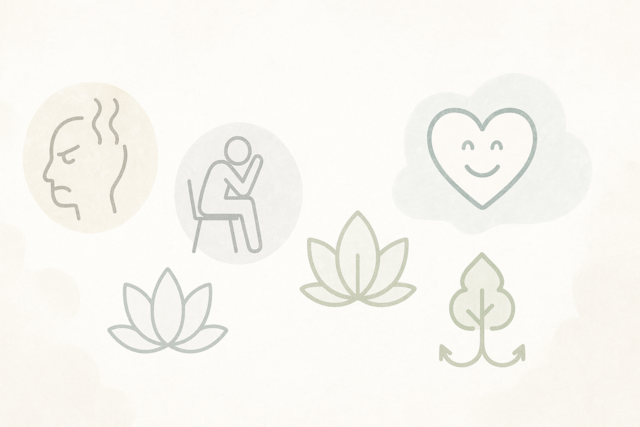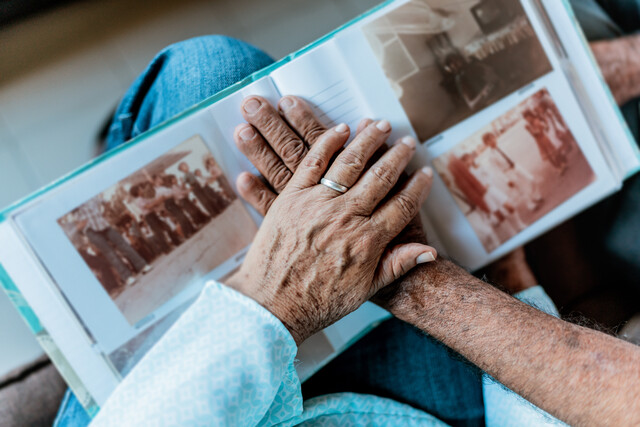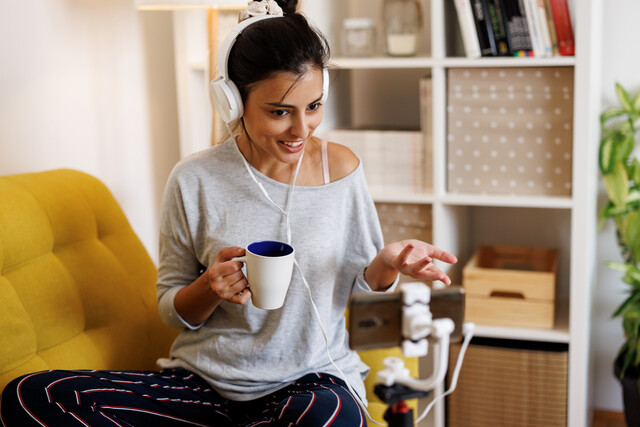Preparation for Meditation
Simplicity is a key component to a proper space for meditation. The space you create, or choose to use, for your meditation need not be exotic. It does not need to be in a "special place" such as a temple or any other spiritual center.
It is important to understand that our ordinary, everyday surroundings, such as our homes, are the ideal places for meditation. We must learn to feel comfortable and at peace in our ordinary surroundings. While we can � and should � make minor modifications to our physical space to enhance our practice of meditation, we must embrace the comfort of our familiar surroundings.
One of the most important considerations for our physical space is the elimination of interruptions. We will explore interruptions in greater detail in a later chapter. Learning how to deal with, and minimize interruptions is a vital step to effective meditation. Our minds are full of thoughts, and we are constantly dealing with external stimuli. Shutting off as many external stimuli as is possible is the first step in creating your physical space for meditation.
Shut off your phones. If possible, lock the door to the room where you will meditate. This is your space now � and it belongs only to you. It will be very difficult to enter a deep state on concentration if someone is allowed to enter the room or if you hear the phone ring. Even if you think you can ignore the ringing of the phone, it will be an impediment to clearing your mind.
You must immerse yourself completely in your meditation practice. Ensure that the people around you � your loved ones, your kids � know that your practice is important to you and that you want some quiet time for yourself.
If you do have young children, perhaps you can make arrangements to ensure they are looked after during your practice. If your spouse or partner is not available to do so, perhaps other arrangements can be made. You will feel more at ease during your practice knowing that they are in the proper care.
Establishing a routine whereby you practice in the same place and at the same time is the ideal situation for meditation. It is important to adopt a commitment to meditate regularly � not just once a week or when you feel especially called to do so. The daily commitment you make to meditation will aid you considerably in achieving a greater sense of harmony and self-awareness.
Early morning is an ideal time for meditation. For many, it is often the easiest time to carve out time from our daily schedules to devote entirely to ourselves. People who are just beginning to practice meditation often find it difficult to find the time to practice each day. Perhaps adjusting your sleep schedule is an option for you whereby you can arise an hour earlier to have some quiet time for yourself. It might seem difficult for the first few days, but after those initial practices, you will find your new routine just that � routine.
Having soft and tranquil music playing during your meditation is especially useful for several reasons. In addition to creating a sense of calmness, it will free you from having to think about time. If you are keeping a portion of your mind tuned to what time it is, or when you need to start your shower to get ready for work, this would be extremely distracting and prevent you from entering into a deep and uninterrupted state of concentration. Playing music would enable you to keep time without thinking about it. When the music stops, your practice is over. If music is not something you'd like to incorporate into your meditation practices, perhaps using a very soft alarm would be a better choice.
The room in which you practice should be clean, well ventilated, and uncluttered. It is especially important that it be uncluttered � we are influenced by our surroundings and one of the main objectives of meditation is an uncluttered, clear mind. If there are windows in the room, keep them open if possible. You should be able to breathe freely, and fresh air would be ideal. We will explore the importance of mindfulness of breathing in a later chapter.
Would incense make your space feel comfortable and tranquil? If so, feel free to use it. Perhaps you have a favorite scent that relaxes you. But, do not think that incense is necessary. Again, we must banish all our stereotypical and preconceived notions about meditation. For some, incense would be an ideal aid to greater concentration. For others, it might simply be an annoyance. If you fall in the latter category, be happy knowing that you know what makes you comfortable. Being comfortable is of paramount importance to your meditation practice.
Visual images of what makes you happy would be an ideal addition to your meditation space. Perhaps you'd like to have photos of loved ones or a cherished vacation spot on your walls, or by your side. Visualization is a key component in meditation � whether it is an image on paper or one seen through our mind's eye. There are many experienced practitioners of meditation who create collages of images to help them visualize the harmony and peace in their lives that they wish to achieve.
Your clothes should be loose fitting, comfortable, and simple. Your favorite cotton T-shirt would be ideal. You don't need fancy gym clothes. As we have learned, simplicity is important.
You should perform your meditation practice on a light or empty stomach. The famous, yet fictional, detective Sherlock Holmes was often quoted as saying that he did his best thinking on an empty stomach out of fear that his digestion of food would divert blood from the brain to the stomach. There is a certain amount of truth to his reasoning. We often feel tired or sluggish after a large meal because a good deal of energy is spent on the digestion of food. You want to have a clear and free mind during meditation. You want your blood flowing freely and copiously through your brain.
We will later explore � in an entire chapter � proper postures for meditation. But, many people, especially beginners, prefer to simply sit on a hard surface, such as the floor, for their meditation. Meditation can actually occur in a variety of positions and activities. As we will soon discover, you can actually meditate very effectively while walking or especially while doing yoga.
Whatever posture you choose to use or activity you engage in, it is important to keep your back straight. You want to be in a relaxed position � but not too relaxed. Many people make the mistake of reclining or laying on a sofa for their meditation. While you want to be as comfortable as possible, you do not want to run the risk of falling asleep. It will happen occasionally, but you want to try to keep your mind as relaxed, open, and alert as possible.
Keep your expectations about meditation in check. Your first few practices are going to make you feel relaxed and invigorated, but don't set yourself up for failure by envisioning yourself enlightened after three days of practice. Keep in mind that persistence in every endeavor is important. In the words of Henry David Thoreau, "If one advances confidently in the direction of his dreams, and one endeavors to live the life which he has imagined, he will meet with a success unexpected in common hours." This is good advice for meditation. A commitment to meditation will be rewarded with greater self confidence, awareness, and peace of mind.
Mindfulness of Breathing
Being mindful of one's breath, however, is one of the most fundamental techniques of meditation. Siddhartha Gautama, the Buddha, or founder of the Buddhist religion, taught mindfulness of breathing and he called it "Anapanasati." It is the most prevalent type of meditation and concentration partly because it is easy to practice.
There are two main types of meditation:
Samadhi Meditation � Concentration Meditation, where one concentrates on a single object voluntarily and effortlessly for a period of time. In traditional Buddhist meditation, there are over 40 objects of meditation, such as earth, water, fire, etc., and breath is clearly one of the most popular objects of meditation among most practitioners.
Vipassana Meditation � Insight Meditation, where one contemplates a situation or a thought, and analyzes one's observations and experience.
Whereas Vipassana meditation is about analysis, thinking, and contemplation, Samadhi meditation is simply concentrating on one single object.
Mindfulness of Breathing is part of the Samadhi family of meditation techniques. It calms the mind, and makes our emotions balanced. It has been practiced for many thousands of years and it is one of the most effective forms of meditation, even for beginners.
Many people who are just beginning meditation become frustrated when they are trying to concentrate on a single object (such as one's breath), and foreign thoughts enter their mind. Perhaps a car passes on the street and our attention is momentarily diverted, or perhaps we hear people walking, engaged in conversation. There are so many stimuli around us and it is easy � and inevitable � that our attention will occasionally be diverted.
It is extremely important to understand, and accept, that it is inevitable that one's attention will occasionally wander. In fact, the practice of mindfulness of breathing is the art of drawing one's attention away from distractions onto one's breath. So distractions actually supply the framework for such a meditation practice. During your mindfulness of breathing practice, you will continually draw your mind's gaze away from everything except your breath.
Mindfulness of Breathing is not a forced concentration. At first it might feel forced because we are drawing our attention away from our surroundings and focusing on a single object, in this case our breath. But, with time, we shall see that Samadhi meditation is effortless and can be sustained, by expert practitioners, for many hours.
The Buddha outlined four steps to Mindfulness of Breathing, and we will begin our practice of meditation with these simple steps.
Some people notice that one of their nostrils is stronger than the other one. Air sometimes flows more freely through one nostril rather than the other. Observe this for yourself, and concentrate on the stronger side.
Normal breathing is typically comprised of long breaths. During times of crisis or stress, we tend to take shorter breaths. So it makes sense that we should begin our practice with long breaths.
Take several deep breaths and concentrate on the sensation of breathing. Feel your abdomen and chest expand as your lungs are filled. Imagine this invisible breath filling your body. After taking several deep breaths, breathe normally, and take notice of the difference. The Buddha instructed his students that one is not finished the first step until one fully appreciates the difference between deep breathing and normal breathing.
Many people who practice mindfulness of breathing recite, or become mindful of, affirmations with each breath. With each deep breath inward think to yourself, "I breathe in calmness and I am at peace." Likewise, with each breath outward, think "I am letting go." There are limitless affirmations you could use. Affirmations are often like prayers � they are all personal and you should choose one that is significant for you.
While our normal breathing is characterized by long breaths, when we are angry, stressed, or afraid, we tend to breathe in short breaths. The main purpose of step 2 is to understand and appreciate the difference between your normal breathing and short breaths. Everything is relative, so what is a short breath to someone might not be a short breath to someone else.
You may not be able to take a great many short breaths in and out as it might become uncomfortable after a short period of time. Return to normal breathing when you feel the need to do so. When you do, notice the difference � consciously notice it. Think about how good it feels to breathe normally. Make a positive affirmation as you deeply inhale, or perhaps just breathe normally and concentrate solely on your breath.
During this step, we observe the whole breathing process, regardless of whether we take short or long breaths, or whether we are just breathing normally. We envision the exact path of our breath as we breathe inward and outward.
The inhalation of breath begins at the opening of our nostrils, or the tip of our nose. Consciously think about the air that enters through your nose, and then proceeds to be drawn into your chest. Envision the air traveling through the nose and into the chest with each inward breathe. Then continue to follow your breath into your abdomen. Feel your breath traveling this short journey.
When you are ready to exhale, follow your breath again. This time it begins in the abdomen. Feel it traveling up into your chest, and finally leaving your nostrils.
This step is not easy for everyone. Some people may find that they can only sense their breath entering their nose and they are unable to "follow" it throughout their body. This will come in time. Mindfulness of Breathing is a process and it need not be rushed.
In this step, we control all abnormal breathing and return to a tranquil, steady breath. Through steps 1 and 2, we reached an appreciation for long and short breaths. We might have had rough, irregular breaths during step 2. In this final step, we turn our attention entirely to calmer breathing.
Think of nothing else besides your breath. Do not characterize it as short or long. Do not concern yourself with labels. Simply breathe normally. Envision your breath entering your nostrils and gently follow its journey throughout your body. Focus your concentration on it � lightly, not forcibly. Interruptions will occur, and this is fine. When they do occur, bring your mind back to your breath. Feel your body, your heart, and your lungs relax in this simple state of calm breathing. In short, be mindful of your breath.






























